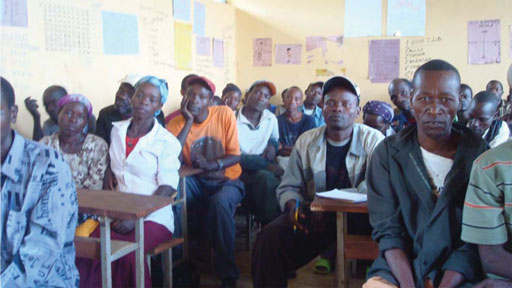9.6 Organising WASH campaigns
A campaign is an organised effort that seeks to influence a decision-making process and is generally appropriate when there is a need to raise awareness of an issue within a particular group. Health communication campaigns apply strategies intended to deliver messages designed to influence health behaviours of target audiences. Messages are communicated, either directly or indirectly, through various channels such as:
- mass media (e.g. television, radio, billboards)
- small media (e.g. brochures, leaflets, posters)
- social media (e.g. Facebook, Twitter, blogs, chat rooms, as shown in Figure 9.6)
- interpersonal communication (e.g. one-to-one or group face-to-face education).

The ten important steps needed to conduct an effective hygiene and sanitation campaign are as follows.
Step 1: Analysing the situation
This is covered by the material you studied in Study Session 8.
Step 2: Defining the target audience
This may be any one or more groups from the primary, secondary or tertiary target populations that you identified in the FOAM framework.
Step 3: Identifying objectives
Identifying objectives is a key starting point when planning a hygiene and sanitation campaign. You should consider your objectives in terms of what needs to change. It may be knowledge, attitudes or practices and it is important to identify and describe specific objectives which can be measured, to help you to identify how the effectiveness of the campaign will be ascertained.
Step 4: Designing the campaign
After the objectives have been identified, the campaign strategy should be defined. This includes deciding upon the type of campaign (for example media-based only or an integrated campaign using several communication channels) and its scale (national, regional or local). When you plan the activities of the campaign, you will need to match the behaviour change campaign activities to the determinants that have been identified in the FOAM framework.
Step 5: Selecting media
Once you have defined the design for an appropriate hygiene and sanitation campaign, careful selection of the right communication media is a critical next step. There are four important factors to consider in selecting the most appropriate campaign media:
- How closely your target audience fits the audience profile of the different media.
- The comparative costs of reaching the target audience through different media.
- The time taken for messages to reach the target audience using the different media and whether this matches the timing of your campaign.
- The appropriateness of the different media for the communication of your message.
Step 6: Planning campaign timing
Timing is crucial. You must create a realistic schedule. Estimate the time required for the campaign and decide how long it will take and use this estimate to decide when your campaign should start.
Step 7: Deciding on frequency required for messages
Campaign messages raise levels of awareness each time they are communicated. They also move individuals further along the decision-making process and can serve to maintain contact during an extended process. Campaigns should use repetition to reinforce the impact of their message, and also provide an opportunity to communicate multiple or complex messages about hygiene and sanitation.
Advertising frequency is often decided by the type of media. For example, meetings can be held weekly, print messages can be released daily, public loud hailer announcements can work twice daily, and radio or television commercials can be broadcast many times during the same day.
Step 8: Setting a budget
There are various costs associated with a campaign and you must plan a careful budget to accommodate them. A campaign budget will include both direct and indirect costs. Direct costs include the costs of designing, writing and producing materials and media costs. Indirect costs can include of the cost of activities such as planning, managing and evaluating the campaign.
Step 9: Delivering the messages
Once the decisions have been made about the appropriate communication channel and the design of the campaign, the campaign messages should be delivered. Messages should be clear and – most importantly – few in number. Try to identify one key message for a campaign with two or three supporting messages that reinforce the central point. Ensure that messages are appropriate for the audience and do not be tempted to ‘say everything’. The message should also be presented to audiences at an appropriate time for the audience to receive, consider and act on the messages.
Messages can be delivered using many communication channels including public announcements, written materials (Figure 9.7), radio and TV broadcasts, and community meetings and discussions, which can take place in many locations including meeting places, market places, churches and mosques (Figures 9.8 and 9.9).



Step 10: Evaluating the campaign
Finally the campaign should be evaluated. The evaluation report ends the campaign process. It is what justifies the work and money spent on the campaign by those who provided the finance, the policymakers, authorities, partners, stakeholders and the campaign team. The final report should provide an overview of each step carried out in preparing and conducting the campaign and its supportive activities. It needs to include an explanation of the rationale for the campaign, the campaign’s basic design, including campaign strategy, how the messages were developed, the communication channel used, and the frequency and intensity at which they were presented.
The evaluation report should end with a discussion and a final conclusion about the strengths and/or weaknesses of the campaign, and its effectiveness.
9.5 Advocacy
